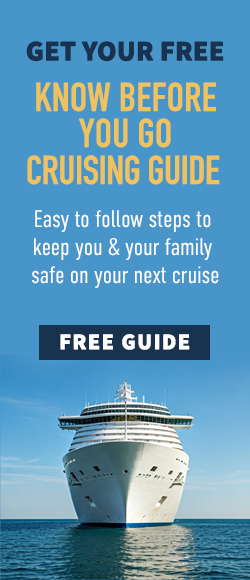By: BRITTANY SHAMMAS, New Times

It was the beginning of a new year, and DeLiberali’s birthday was coming up. So was her son-in-law’s. The trip was supposed to be a celebration.
Instead, it turned into a nightmare for the family of seven and 4,000 other passengers. Despite days of warnings about a storm of historic proportions taking shape along the East Coast, the Breakaway stuck to its itinerary and sailed straight into what’s called a bomb cyclone — essentially a winter hurricane. As the ship listed, water poured into the staterooms and furniture slammed to the floor.
Now, a little over a year after enduring the cruise from hell, DeLiberali and her family are among 200-some passengers suing the Miami-based Norwegian Cruise Line (NCL). In a complaint recently filed in federal court in South Florida, the jilted travelers accuse the cruise line of negligence for knowingly sailing into the massive weather system. They say they suffered severe distress, citing the violent storm conditions that caused “a reasonable fear of death and the sinking of the vessel.”
Their attorney, Michael Winkleman of the Miami firm Lipcon, Margulies & Winkleman, points out this isn’t the first time a cruise line put passengers in the path of a major winter storm. In February 2016, Royal Caribbean’s Anthem of the Seas was damaged and its passengers badly shaken after a day of hurricane-strength winds and waves on a voyage from New Jersey to Florida.
“This isn’t a one-off,” says Winkleman, whose office also represented passengers on that ship. “And you really have to see it from [the cruise line’s] perspective, which is if they don’t stay on itinerary, they don’t make money. So for them to deviate from their course means a tremendous loss of revenue to them in a number of different ways, and in my opinion, that’s a big driving factor as to why they’re willing to put passengers’ lives at risk. It’s the almighty dollar, which is really tragic.”
NCL, which passengers said did not offer refunds after the harrowing experience, declined to comment on the lawsuit. The company previously blamed the tumultuous journey on “stronger than forecasted weather conditions.”
But as the lawsuit points out, warnings of a severe storm came as early as December 31. That day, the National Weather Service’s Ocean Prediction Center forecasted “very dangerous Atlantic marine conditions expected later this week” and urged “marine interests” to watch closely for updates. Similar forecasts were issued over the next couple of days.
Around 5:30 a.m. January 2, the Ocean Prediction Center warned that a “powerful storm” with “hurricane-force winds” would move northeast off the coast January 3 and 4. The center also indicated winds would increase to 80 knots and seas to 33 feet by January 4.
More than 12 hours after that warning, around 6 p.m. January 2, the Norwegian Breakaway left the Bahamas for New York. The passengers had little idea of what lay ahead. DeLiberali says she noticed the waters growing rough and the wind picking up. But NCL employees weren’t transparent about what the ship was about to encounter.
“You really felt as though you were left unknowing and in the dark,” DeLiberali recalls.
On January 3, just as predicted, the waves picked up. People became seasick. The crew tried to serve food, but everything was flung off the tables and onto the floor. That night, passengers were thrown from their beds. Water soaked the carpet and came through the sliding glass door in DeLiberali’s room.
Navigating the hallways was difficult, she says. “Depending on where you were, you felt as though you were climbing because the ship was literally on its side.”
As conditions deteriorated, the captain repeated the same message: “Ladies and gentlemen, we are in rough seas, and we are optimizing our speed and course to minimize the movement of the ship.”
It was hardly reassuring to the terrified passengers, many of whom left their staterooms for the common areas of the ship. DeLiberali remembers seeing people wandering the hallways in life jackets.
“There were people in the atrium just kind of huddled up in the fetal position with blankets,” she says. “Just sheer panic.”
When her daughter asked if she thought the family would die on the ship, DeLiberali assured her everything would be all right. But privately, she wasn’t sure. The waves were so large, and the ship was tilting so far to the side.
The storm lasted around 48 hours. But aboard the ship, it felt endless, DeLiberali says.
“I really believe that a lot of people never thought they would see land again,” she says.








